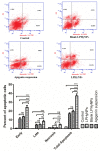Apigenin Loaded Lipoid-PLGA-TPGS Nanoparticles for Colon Cancer Therapy: Characterization, Sustained Release, Cytotoxicity, and Apoptosis Pathways
- PMID: 36080654
- PMCID: PMC9460590
- DOI: 10.3390/polym14173577
Apigenin Loaded Lipoid-PLGA-TPGS Nanoparticles for Colon Cancer Therapy: Characterization, Sustained Release, Cytotoxicity, and Apoptosis Pathways
Abstract
Colon cancer (CC) is one of major causes of mortality and affects the socio-economic status world-wide. Therefore, developing a novel and efficient delivery system is needed for CC management. Thus, in the present study, lipid polymer hybrid nanoparticles of apigenin (LPHyNPs) was prepared and characterized on various parameters such as particle size (234.80 ± 12.28 nm), PDI (0.11 ± 0.04), zeta potential (−5.15 ± 0.70 mV), EE (55.18 ± 3.61%), etc. Additionally, the DSC, XRD, and FT-IR analysis determined drug entrapment and affinity with the selected excipient, demonstrating a promising drug affinity with the lipid polymer. Morphological analysis via SEM and TEM exhibited spherical NPs with a dark color core, which indicated drug entrapment inside the core. In vitro release study showed significant (p < 0.05) sustained release of AGN from LPHyNPs than AGN suspension. Further, the therapeutic efficacy in terms of apoptosis and cell cycle arrest of developed LPHyNPs against CC was estimated by performing flow cytometry and comparing its effectiveness with blank LPHyNPs and AGN suspension, which exhibited remarkable outcomes in favor of LPHyNPs. Moreover, the mechanism behind the anticancer attribute was further explored by estimating gene expression of various signaling molecules such as Bcl-2, BAX, NF-κB, and mTOR that were involved in carcinogenic pathways, which indicated significant (p < 0.05) results for LPHyNPs. Moreover, to strengthen the anticancer potential of LPHyNPs against chemoresistance, the expression of JNK and MDR-1 genes was estimated. Outcomes showed that their expression level reduced appreciably when compared to blank LPHyNPs and AGN suspension. Hence, it can be concluded that developed LPHyNPs could be an efficient therapeutic system for managing CC.
Keywords: apigenin; apoptosis; colon cancer; hybrid nanoparticle; mTOR; sustained release.
Conflict of interest statement
The authors declare no conflict of interest.
Figures










Similar articles
-
Formulation and Evaluation of Apigenin-Loaded Hybrid Nanoparticles.Pharmaceutics. 2022 Apr 3;14(4):783. doi: 10.3390/pharmaceutics14040783. Pharmaceutics. 2022. PMID: 35456617 Free PMC article.
-
Sonication tailored enhance cytotoxicity of naringenin nanoparticle in pancreatic cancer: design, optimization, and in vitro studies.Drug Dev Ind Pharm. 2020 Apr;46(4):659-672. doi: 10.1080/03639045.2020.1747485. Epub 2020 Apr 8. Drug Dev Ind Pharm. 2020. PMID: 32208984
-
Brigatinib loaded poly(d,l-lactide-co-glycolide) nanoparticles for improved anti-tumoral activity against non-small cell lung cancer cell lines.Drug Dev Ind Pharm. 2021 Jul;47(7):1112-1120. doi: 10.1080/03639045.2021.1983585. Epub 2021 Oct 1. Drug Dev Ind Pharm. 2021. PMID: 34551665
-
Oseltamivir phosphate loaded pegylated-Eudragit nanoparticles for lung cancer therapy: Characterization, prolonged release, cytotoxicity profile, apoptosis pathways and in vivo anti-angiogenic effect by using CAM assay.Microvasc Res. 2022 Jan;139:104251. doi: 10.1016/j.mvr.2021.104251. Epub 2021 Sep 11. Microvasc Res. 2022. PMID: 34520775
-
Formulation optimization of etoposide loaded PLGA nanoparticles by double factorial design and their evaluation.Curr Drug Deliv. 2010 Jan;7(1):51-64. doi: 10.2174/156720110790396517. Curr Drug Deliv. 2010. PMID: 20044908 Review.
Cited by
-
Targeting drug resistant colorectal cancer with apigenin nanoarchitectures.Transl Oncol. 2025 Sep;59:102455. doi: 10.1016/j.tranon.2025.102455. Epub 2025 Jun 24. Transl Oncol. 2025. PMID: 40561797 Free PMC article. Review.
-
Tumor-Targeted Magnetic Micelles for Magnetic Resonance Imaging, Drug Delivery, and Overcoming Multidrug Resistance.ACS Omega. 2024 Dec 9;9(50):49566-49579. doi: 10.1021/acsomega.4c07132. eCollection 2024 Dec 17. ACS Omega. 2024. PMID: 39713686 Free PMC article.
-
A comprehensive view on the apigenin impact on colorectal cancer: Focusing on cellular and molecular mechanisms.Food Sci Nutr. 2023 Aug 28;11(11):6789-6801. doi: 10.1002/fsn3.3645. eCollection 2023 Nov. Food Sci Nutr. 2023. PMID: 37970406 Free PMC article. Review.
-
The Therapeutic Effects of Bioactive Compounds on Colorectal Cancer via PI3K/Akt/mTOR Signaling Pathway: A Critical Review.Food Sci Nutr. 2024 Nov 7;12(12):9951-9973. doi: 10.1002/fsn3.4534. eCollection 2024 Dec. Food Sci Nutr. 2024. PMID: 39723045 Free PMC article. Review.
-
Apigenin: A Bioflavonoid with a Promising Role in Disease Prevention and Treatment.Biomedicines. 2024 Jun 18;12(6):1353. doi: 10.3390/biomedicines12061353. Biomedicines. 2024. PMID: 38927560 Free PMC article. Review.
References
-
- Slattery M.L., Mullany L.E., Sakoda L., Samowitz W.S., Wolff R.K., Stevens J.R., Herrick J.S. The NF-ΚB Signalling Pathway in Colorectal Cancer: Associations between Dysregulated Gene and MiRNA Expression. J. Cancer Res. Clin. Oncol. 2018;144:269–283. doi: 10.1007/s00432-017-2548-6. - DOI - PMC - PubMed
Grants and funding
LinkOut - more resources
Full Text Sources
Research Materials
Miscellaneous

